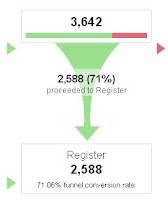Conversion rate is calculated by total number of visitors completing a target actions divided by a “relevant denominator” (Sometimes it is total number of target actions divided by a “relevant denominator).
The key here is “relevant denominator”. This is often ignored by many organization and they tend to use the default denominator provided by their Web Analytics tool provides. The most common denominator used by most of the tools is either total visits or total visitors.
If you are an eCommerce site then potentially every visitors or visit is a target for conversion and “Total Visits” or “Total Visitors” as a denominator might make sense. However if your site is a non-eCommerce site and conversion to you means getting people to register on the site then using a denominator like total visits or total visitors to calculate conversion rate, wrongly assumes that all of the visits to sites have not previously converted (registered) and hence are potential conversion worthy. We all know that’s not the case. These sites get a mix of visitors, visitors who have registered in past and are not going to register again and, visitors who have not registered yet and hence are a potential target. Examples of such sites are facebook, WSJ.com, espn, yahoo etc.
Calculating the Right Conversion rate
In my examples I will assume that number of visits is equal to the number of visitors.
Hypothetical site in our examples is a portal that requires visitors to login (register) for some actions but also has content that does not require a login.
This sites gets an average of 1000 visits a day and gets 50 new registrations (conversions) a day. By most common way of calculating the conversion rate, the conversion rate for this site is 5% (i.e. Conversion Rate = Conversions/Total Visits = 50/1000 = 5%)
Let’s assume that every day this site gets 50% of the visits from the people who have registered in past. So that means 500 (50% of 1000) are registered and won’t register again. Since they are not going to register, why do we even consider them when calculating the conversion rate? By removing them from the calculation of conversion rate, the new conversion rate becomes:
50/500 = 10% (Immediately you doubled your conversion rate)
Why is this important?
Let’s look at two scenarios to illustrate the importance of choosing a relevant denominator.
- Scenario 1
One day the customer retention department sends some emails to previously registered visitors that result in 500 more visits from people who had previously registered. As a result the site got 1500 instead of 1000 visits it used to get every day. Considering that nothing else changed on the “not-registered” visitor base, the site got 50 conversions, just like any other day.
Using “Total Visits” as the denominator, it appears that the conversion rate drops to 50/1500 = 3.33%
It looks bad, and might cause you to panic. Won’t it? However if you choose the right denominator you will find out that nothing really changed. The pool of people who had not previously registered is still 500, so the true conversion rate is still the same
50/500 = 10%. - Scenario 2
The “customer acquisition” department bought a new email list and sends emails to this list which resulted in 500 extra visits. Overall the site got 1500 customers, 1000 who had never registered and 500 who had registered previously. That day the site got 60 registrations, resulting in a conversion rate of
60/1500 = 4%.
Look like our email list did not work because it caused the conversion rate to go down.
This might cause you to wrongly assume that the email list that the retention department bough was not as good as the other traffic that you have been getting. However when you calculate the true conversion rate, it turns out that the email list actually worked; it resulted in a conversion rate of 6% (60/1000).
Hope this gives you an a reason to investigate what denominator you are using in your conversion rate.
In the next post, I will show you how you can calculate the “True Conversion Rate” using Google Analytics.
New Job: Analytics Associate at Huge (Brooklyn, NY)
Looking to fill your Web Analytics or Online Marketing position?
Post your open jobs on Web Analytics Job Board
--------------------------------------------------------------------------




